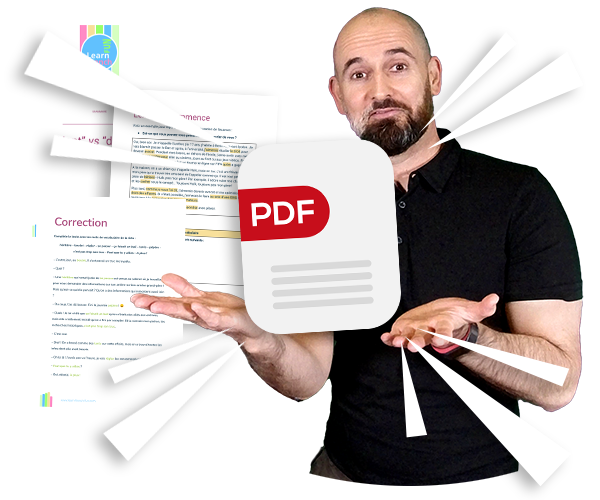The French gerund is a verb form that is unique to the French language and is used quite differently than in English. There are many different rules that govern its use. In this article, we will explore all the secrets of the French gerund!
- The French gerund can be used in all levels of language (supported or vulgar).
- The gerund in French is easy to construct.
- The gerund does not change, regardless of the tense of the sentence.
- In French, the gerund allows you to express 4 different ideas (temporal, cause/manner, condition, opposition).
Using the gerund in your DELF B2 oral exam is a very good strategy: not many students do it, so it will be very positive for you, and it’s a lot less difficult than you might think! It’s like using indirect French pronouns (lui, leur…) correctly!
Today I’m going to teach you all about the French gerund. You may not think it’s important, but trust me, this little verb form can be tricky!
So pay close attention, and by the end of this post you’ll be able to use the gerund like a pro! And you’ll see that when you’re writing French (for exam…), or simply when you write French, it’s very practical, because it makes sentences less “heavy” while still conveying complex ideas.
- The French gerund can be used in all levels of language (supported or vulgar).
- The gerund in French is easy to construct
- The gerund does not change, regardless of the tense of the sentence
- In French, the gerund allows you to express 4 different ideas (temporal, cause/manner, condition, opposition)
- There is only one condition for using the gerund in French

PDF Bonus
We have prepared a free PDF to help you understand and master the gerund in French.
👉 Download it for free
At the end, you will have exercises to practice with the correction. 👍
The French gerund can be used in all levels of language (supported or vulgar).
Il écoute la radio en préparant le dîner.
(He listens to the radio while cooking dinner.)
Wahoooo…Here’s a human being who multitasks: he can do two things at the same time, isn’t that great? He can make dinner and listen to the radio at the same time. 😆
Well, it’s not like it’s death to be able to do these two things at the same time! But it was just a pretext to introduce my lesson of the day: the gerund. And you don’t know how lucky you are because I love teaching the gerund.
The gerund is something you can use with all language levels:
you can speak in a very sustained level or in a very vulgar one by using the gerund. Here is a small demo with 2 examples:
French gerund in sustained level
Je vous prierai d’avoir l’obligeance de prêter l’oreille à mes propos tout en gardant bouche close.
(I would like to ask you to be so kind as to listen to what I have to say while keeping your mouth shut).
French gerund in vulgar level
T’as qu’un truc à faire, putain, fermer ta grande gueule en écoutant c’que j’ai à t’dire.
(You’ve only got one thing to do, shut your big mouth and listen to what I have to say).
In short, in standard language, in these 2 examples, I ask the person to listen to me in silence.
Do you like learning French with videos?
Receive our free video newsletter every Friday in your e-mail box. You will get 3 “Tips & Tricks” on grammar, vocabulary, phonetics or French culture.
👉👉 Sign up now!
The gerund in French is easy to construct
The gerund always has 2 parts:
the preposition en + the verb.
In the example at the beginning : Il écoute la radio en préparant le dîner. (He listens to the radio while cooking dinner), it’s easy: the gerund of the verb “préparer” is “en préparant“. Life is good!
For other verbs, it sometimes takes a little more work, but there is… a rule to form the French gerund:
- you start from we in the present tense,
- you cut the final -ons of the present tense
- and instead, you stick -ant of the gerund.
- and don’t forget the preposition “en” before.
Don’t panic… I’ll give you some examples.
Let’s take for example, well let’s take… the verb “prendre” (to take):
- In the present tense, with “nous” (we), the verb is : prenons.
- I cut -ons
- and I paste -ant.
- And here it is, the gerund of “prendre” is “en prenant” (don’t forget the preposition en)
Now it’s your turn. I give you 4 verbs and you have to find the gerund. Are you ready? So what is the gerund of the verbs finir (to finish), boire (to drink), faire (to do) and voir (to see)?
Tictac tictac, you have 30 seconds… Countdown 😀
Shall we correct?
“Finir” in French gerund
For the verb”finir” (to finish):
You start from the present tense: nous finissons, and the gerund will be: en finissant.
“Boire” in French gerund
To drink, the present tense is: nous buvons, the gerund is: en buvant.
“Faire” in French gerund
To do, be careful with the pronunciation of the present tense: we say “je fais, tu fais, il fait…” and we pronounce “nous faisons“. And the gerund respects the pronunciation of the present tense with we. Therefore I pronounce: “en faisant“.
“Voir” in French gerund
For the last verb, voir (to see), the present tense: nous voyons, becomes: en voyant in the French gerund.
3 exceptions in French gerund
There are just 3 exceptions, 3 verbs that do not form in the present tense. These ones, sorry buddy, you have to learn them! They are the verbs :
- “être” (to be) → en étant
- “avoir” (to have) → en ayant
- and “savoir” (to know) → en sachant
in the French gerund.
The gerund does not change, regardless of the tense of the sentence
Oh, and another cool feature of the French gerund (I forgot about that one) is that the gerund doesn’t change, regardless of the tense of the sentence.
Listen carefully, I’m going to give you 4 examples of sentences:
The 1st in the present tense:
Anne gagne bien sa vie en faisant des traductions.
(Anne makes a good living doing translations)
The 2nd in the future tense:
Gisèle ira plus vite en prenant le tramway.
(Giselle will go faster by taking the streetcar)
The 3rd in the imperfect tense:
Rina perdait du poids tout en mangeant comme 4.
(Rina lost weight while eating like 4)
The 4th in the past tense (passé composé):
Christian a couru en voyant le train arriver.
(Christian ran when he saw the train coming)
You see, the gerund doesn’t change. OK, it’s true that sometimes you can find a special form for the past tense, you could say:
Christian a couru en ayant vu le train arriver.
That might be grammatically correct, but frankly, it’s really not often used and Christian a couru en voyant le train arriver, that works very well.
In French, the gerund allows you to express 4 different ideas (temporal, cause/manner, condition, opposition)
Let’s move on to the ideas that the gerund can express. I told you earlier that there were four of them. Remember?
- A temporal idea,
- a cause or manner idea,
- a condition idea
- and, an opposition idea.
And now it’s your turn to do a little work… I’m not going to do everything! So, can you find which idea is expressed by the gerund in the 4 sentences I gave you before? I’ll give them back to you:
- Anne gagne bien sa vie en faisant des traductions. (Anne makes a good living doing translations)
- Gisèle ira plus vite en prenant le tramway. (Giselle will go faster by taking the streetcar)
- Rina perdait du poids tout en mangeant comme 4. (Rina lost weight while eating like 4)
- Christian a couru en voyant le train arriver. (Christian ran when he saw the train coming)
In the 1st sentence: Gerund for manner
The gerund expresses an idea of manner. It answers the question How?:
How does Anne earn her living? Answer: by doing translations.
In the 2nd sentence: Gerund for condition
The gerund expresses an idea of condition.
You could rephrase the sentence with the word “si” (if):
Gisèle ira plus vite si elle prend le tramway. (Giselle will go faster if she takes the streetcar.)
In the 3rd sentence: Gerund for opposition
The gerund expresses an idea of opposition.
It’s not logical, no, to lose weight when you eat a lot!
So you could rephrase the sentence with “même si” (even if) or “bien que” (although):
Même si elle mangeait comme 4, Rina perdait du poids (even if she ate like 4, Rina lost weight)
ou: Bien qu’elle mange comme 4, Rina perdait du poids.
Note: With although, don’t forget that you have to use the subjunctive.
And finally, in the 4th sentence: Gerund for temporal idea
The gerund expresses a temporal idea.
You could rephrase the sentence as follows:
Christian a couru quand il a vu le train arriver. (Christian ran when he saw the train coming.)
The gerund could also express a causal idea:
Christian a couru parce qu‘il a vu le train arriver. (Christian ran because he saw the train coming.)
There is only one condition for using the gerund in French
And that’s it… Oh no, I forgot one little detail. There is one condition to use the gerund in a sentence : the subjects of the 2 parts of the sentence must always be the same.
If you take the last example, you can see that Christian is the subject of both verbs: it’s Christian who sees the train coming and it’s Christian who runs to catch it…
Another multi-task human being!
So, there you have it! The French gerund is a unique verb form that can be used to express a variety of different ideas.
It’s important to understand all the different rules governing its use, but once you do, this handy little verb will add an extra layer of nuance and sophistication to your French language skills.
Have fun using the gerund in all sorts of creative ways – just make sure you know what you’re doing before you try using it in a conversation with a native speaker!
Articles that might interest you:
- The Imperative in French: How to Conjugate Verbs in Imperative? When do You Have to Use the Imperative?
- The 10 Irregular Verbs in the French Subjunctive Mood
- Depuis, pendant, en, il y a, dans
- All the secrets of the French gerund!
- French verb moods
- How to use the tonic pronouns in French?
- How to use “en” and “y” pronoun in French?
- Difference between DONT and DUQUEL in French
- 10 common French verbs conjugated in the present tense. Beware of traps!
- The Direct Object Complement in French (C.O.D.) and direct complement pronouns (le, la, les…)




1 thought on “All the secrets of the French gerund!”
Comments are closed.